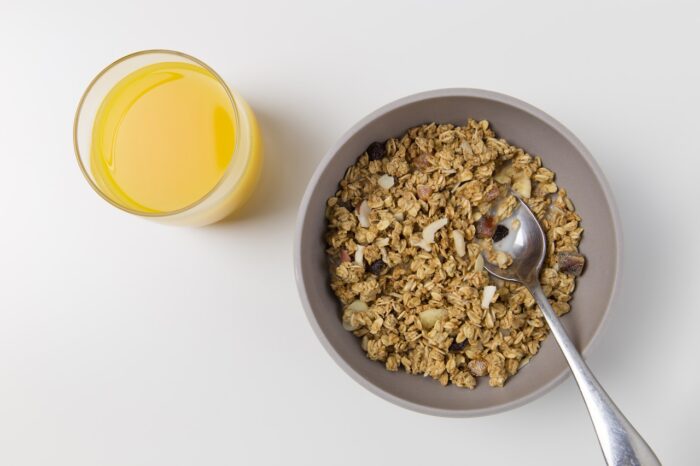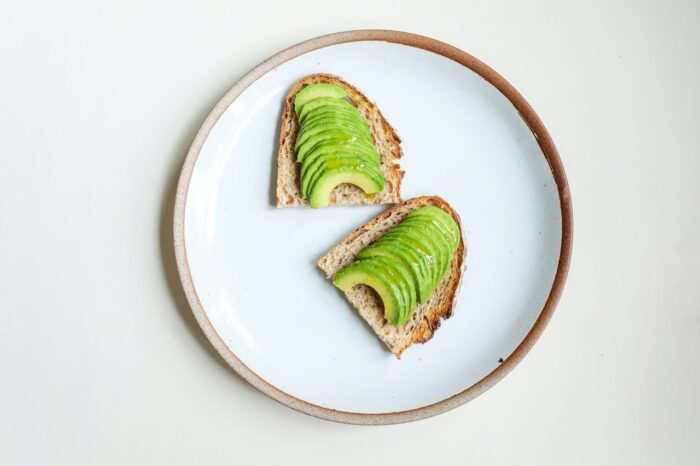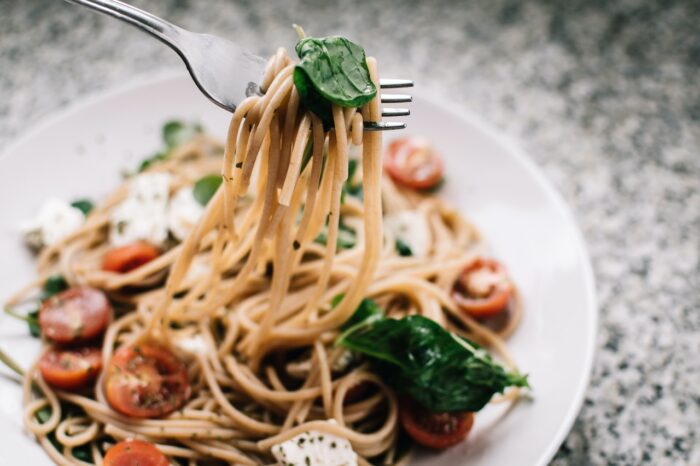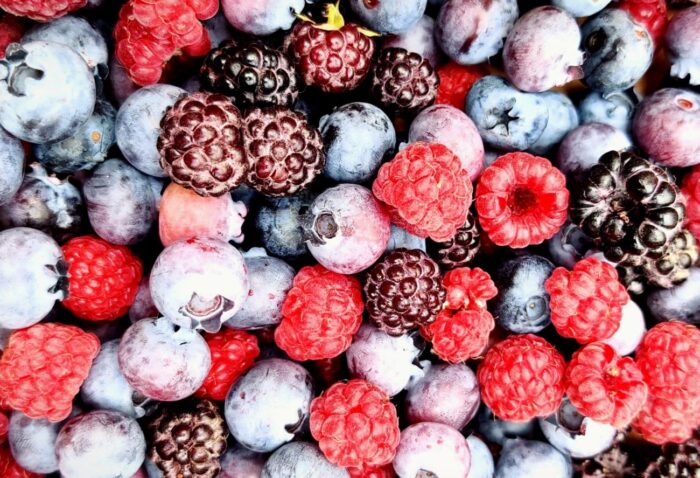How to Get More Fiber in Your Diet—10 Easy Ways!
Fiber helps fill you up, supports digestive health, aids weight loss and so much more. If you’re looking to take advantage of all that fiber has to offer and wondering how to get more fiber in your diet, read on!

What is fiber?
When you think of fiber, you probably picture a sad bowl of bran flakes or your grandma’s Metamucil. Hard pass, thanks! Fiber’s reputation is anything but sexy but get enough of it in its whole food form, and you are sure to feel sexier… eventually.
Fiber is a type of carbohydrate found in plant-based foods like fruits, veggies, legumes, and whole grains. In fact, plant-based foods are the only foods that naturally contain fiber.
Unlike with protein, fat, and the other carbohydrate types (sugars and starches), your body can’t break down fiber and (directly) use it for energy because you don’t have the digestive enzymes needed to do so. Instead, fiber works its magic by sliding through your gut relatively intact but not unnoticed.
What does fiber do for the body?
There are two main fiber types found in foods: soluble and insoluble.
- Soluble: As soluble fiber passes through your gut, it absorbs water to form a gel that slows stomach emptying and digestion, which keeps you fuller for longer. In the small intestine, this gel entraps sugars, cholesterol, and fats, slowing their absorption into the bloodstream (even preventing some from being absorbed altogether).
- Fermentable: Most soluble fibers are also fermentable—meaning gut bacteria can use them as a fuel source—and may have prebiotic properties, too.
- Insoluble: Insoluble fiber can’t absorb water and instead acts as nature’s broom, helping move things along and increasing stool bulk. For the most part, insoluble fibers are poorly or non-fermentable.
Although it’s good to be aware of this distinction, there’s no need to stress too much over it because a) most fiber-rich foods contain a mix of fiber types, and b) consuming a variety of fiber-rich foods sources will help you get a good mix of them all.
But together, soluble and insoluble fiber duo boast quite a resume. They can help lower cholesterol, support digestive health, and more.
Benefits of a high-fiber diet
It’s thought that a lack of dietary fiber is a primary feature of the typical Western diet that has led to a rise in chronic disease, which is why it’s important to get enough fiber in the diet.
The benefits of a high-fiber diet include:
- Lowers total cholesterol and LDL-cholesterol (aka “bad” cholesterol). Soluble fiber essentially helps your body flush out excess cholesterol and forces your liver to pull cholesterol from the blood to make more bile acids, thus decreasing the amount of “gunk” that can build up in your arteries and lead to atherosclerosis (plaque build-up and hardening of the arteries).
- Improves blood sugar control. That same “gel” formed by soluble fiber can also attract sugar molecules, delaying their absorption into the bloodstream.
- Keeps you regular. Fiber provides bulk to your stool and can help it move through you smoothly (gross, but awesome).
- Supports gut health. Some fibers function as prebiotics, fueling the growth and activity of beneficial gut bacteria. As your good gut bacteria ferment these prebiotics, they release beneficial byproducts known as short-chain fatty acids (SCFAs) which serve as a main energy source for the cells lining your colon.
- Supports weight loss/management. Fiber fills you up both directly and indirectly, all while contributing little to no calories. Additionally, fiber can positively influence the composition and activity of your gut microbiome, which in turn influences satiety, blood sugar control, insulin sensitivity, and inflammation for the better. And all those things play a role in weight management.
- Protects against colorectal cancer. In one systematic review of prospective cohort studies, a 10 percent risk reduction was found for every 10 grams of fiber eaten per day.
How much fiber do you need?
Fiber intake recommendations from the Institute of Medicine (IOM) for women and men are 25 and 38 grams per day, respectively. (These numbers fall to 21 and 30 grams per day for those over the age of fifty.) Daily fiber recommendations from the 2020-2025 Dietary Guidelines for Americans fall in line with those from the IOM, recommending 22 to 28 grams per day for women and 31 to 34 grams per day for men.
Only 5% of Americans meet the daily fiber recommendations, with the average intake in the United States being approximately 16 grams per day—meaning a lot of people need to almost double their fiber intake.
This may seem like a daunting and even impossible task, but don’t worry—we’ve got you covered! Read on to find out how to get more fiber in your diet with minimal effort.
How to get more fiber in your diet—10 easy ways!

Add avocado
As if you needed another reason to love avocados. Not only are avocados rich in heart-healthy fats, but they are also high in fiber. One medium-sized avocado has about 10 grams of fiber.
There are many ways to enjoy this versatile fruit (yes, it’s a fruit):
- Top some whole wheat toast with mashed avocado a la avocado toast
- Use avocado as a creamy substitute for mayo in your sandwich
- Add some avocado to your smoothies
- Make a creamy pasta sauce or pesto with avocado
- Top your salads with sliced avocado
Sprinkle on some seeds
Try incorporating a tablespoon or two of small seeds, like chia, flax, or hemp, into your day. These seeds may be small in size but they’re mighty in nutritional power, providing you with heart-healthy fats and protein in addition to plenty of fiber. An ounce of chia seeds, for example, provides a whopping 10 grams of fiber.
And since they’re relatively tasteless, it’s easy to incorporate them into a variety of your meals and/or snacks. You can:
- Blend ground flaxseed into your smoothie
- Add ground flaxseed to your baked goods
- Sprinkle hemp seeds on your avocado toast
- Use hemp seeds in a homemade pesto
- Make chia pudding out of chia seeds
- Mix flax and/or chia seeds into your oatmeal

Sip on a smoothie
Smoothies are the perfect vessel for good-for-you stuff, like fiber! It’s so easy to fit a big dose of fiber into a smoothie without feeling like you’re sipping on sawdust.
So, how do you build the perfect, fiber-rich smoothie? It’s simple. After picking your protein of choice, add a serving each of fruit and veggies (like spinach, kale, or frozen cauliflower rice).
All produce has some fiber, but you can up the fiber content of your smoothie even more by adding a couple of servings of fiber-rich healthy fats. Great options for a smoothie include flax seeds, hemp seeds, nut butters, and avocado.
Want to know our secret formula for how to make healthy weight loss smoothies plus 5 recipes for the best smoothies for weight loss? Check out our Ultimate Weight Loss Smoothies Guide!
Get creative with veggies
You seriously can’t go wrong adding more veggies to your diet. Non-starchy vegetables, like leafy greens, broccoli, and cauliflower, provide both fiber and volume for little calories.
Veggies can often seem bland and unappetizing, so it’s important to find creative ways to incorporate more veggies into your day. Here are some ideas:
- Mix some veggie noodles (i.e. “zoodles”) into your spaghetti dish
- Add some cauliflower rice to your fried rice (no need to completely replace the actual rice)
- Add some veggies to your smoothie (frozen cauliflower rice and spinach work great here)
- Blend veggies into your sauces (for example, blending spinach into a pesto sauce)
- Turn your morning eggs into a veggie omelet
- Serve sliced cucumber and bell pepper with your crackers and hummus
- Add some cauliflower rice to your morning oatmeal
Speaking of blending veggies into your sauces, give this “Caulifredo”—aka creamy cauliflower alfredo sauce—recipe a try!

Switch up your pastas
There’s a place for Olive Garden-style white pasta in a balanced diet. However, it’s in your best interest to choose whole grain and legume-based pastas most of the time.
Legume-based pastas like Banza chickpea pasta and Barilla lentil pasta provide 5 to 8 grams fiber per serving, at least triple what white pastas provide. And don’t forget about whole grain pastas, too. One serving of Barilla Whole Grain Penne provides 7 grams fiber per serving.
Opt for oats
Oats are a nutritional powerhouse known for being rich in beta-glucan—a soluble fiber that functions as a prebiotic fiber and has been shown to be particularly effective at lowering total and LDL cholesterol.
You can enjoy oats for breakfast in a variety of ways: overnight oats, baked oatmeal, oat pancakes, oat muffins, and more. For a less conventional way of getting oats into your diet, try using oat flour (oats blended into a flour-like consistency) as a breadcrumb replacement in meatballs or your favorite veggie burger recipe.

Fill up on berries
Which fruits have the most fiber? All fruits contain fiber, but berries—specifically raspberries and blackberries—take the cake. Just one cup of raspberries or blackberries contains a whopping 8 grams of fiber—about a third of the daily fiber recommendation for women.
To easily incorporate berries into your diet, try enjoying some as a yogurt or oatmeal topper, in a smoothie, or even on a salad.
Switch up your snacks
Snack time is one of the best times to up your fiber intake since fiber can help you feel full and pump the breaks on mindless snacking. There are so many fiber-rich snacks to choose from, but here are some dietitian favorites:
- Roasted chickpea snacks, homemade or store-bought (like these Biena chickpea snacks)
- Air-popped, lightly-seasoned popcorn (tip: make your own snack mix to up the fiber even more by adding nuts and dried or freeze-dried fruit)
- Apple or pear slices with nut butter
- Sliced veggies with hummus and/or guacamole
- Cooked and salted edamame
Swap some plant proteins for animal ones
The plant-forward movement isn’t stopping anytime soon and for good reason. Plant and animal proteins each offer unique nutritional benefits, but there’s one big thing plant proteins have that animal ones lack: fiber.
Almost all plant proteins provide some amount of fiber, but those richest in fiber include beans, chickpeas, lentils, quinoa (and other “ancient”/whole grains), tempeh, and nuts.
If you’re not accustomed to incorporating plant-based foods into your diet, start slow. Try participating in meatless Mondays or focusing on incorporating one plant-based protein into each day. You can also try subbing out an ounce or two of meat/poultry in your dish for about a quarter-cup of cooked beans, chickpeas, or lentils. For example, make a burrito bowl with two to three ounces cooked chicken breast and a scoop of black beans. Or swap out half the meat in your Bolognese sauce for canned lentils.

Pick a better bread
Whole and sprouted grains can pack a serious fiber punch. And randomized controlled trials involving an increase in the intake of whole grains showed reduction in bodyweight and cholesterol, likely reflecting their high fiber content. In fact, an average intake of three servings of whole grains per day was linked with lower BMI and less belly fat. Additionally, consumption of three servings a day of whole grains has been linked with a nearly 20% reduced risk in colorectal cancer.
No matter how you slice it, bread is a staple in the American diet. Although white bread contains a range of vitamins and minerals, it often has significantly less fiber than whole grain and sprouted breads. For example, compare traditional Thomas’ English Muffins to Food For Life Sprouted Whole Grain English Muffins and you’ll notice that the latter provides 6 times, or 5 grams, more fiber.
You can easily increase your fiber intake by swapping out most (not necessarily all) of your white bread and bread products for their whole counterparts. When shopping for whole grain breads, you may have to do a little extra investigating because labels can be extremely deceptive.
Here are some tips:
- If you see “100% whole wheat” or “100% whole grain” on the packaging, then you can be sure the product is made up entirely of whole grains.
- Take a peek at the ingredient list. If wheat flour is used, you’ll want to see the word whole in front of it (e.g., “whole wheat flour” instead of just “wheat flour” or “enriched wheat flour”) or sprouted. Sprouted grains are by necessity whole grains because you can’t sprout a refined grain.
- Look for close to a 5:1 ratio of total carbohydrates to dietary fiber. (For example, if a slice of bread has 15 grams total carbs, you’ll want to see ~3 grams of fiber). An easy way to calculate this when looking at a nutrition label is to add a zero to the fiber number and it should be about double the total carbohydrate number.
Bottom line
Fiber is a type of carbohydrate we could all benefit from getting more of in the diet. It supports cardiovascular health, gut health, weight loss, and more.
If you’ve been wondering how to get more fiber in your diet, there are many easy ways to up your fiber intake. By incorporating some of the ideas above into your daily routine, you can easily increase your fiber to meet the daily recommended intake.




I was in tears and pain, suffering from Herpes for the past 2 years, and ever since then I have been taking series of treatment but there was no improvement until I came across testimonies of Dr. happy on how he has been curing different people from different diseases all over the world, then I contacted him as well. After our conversation he sent me the medicine which I took according .to his instructions. When I was done taking the herbal medicine I went for a medical checkup and to my greatest surprise I was cured from Herpes. My heart is so filled with joy. If you are suffering from Herpes or any other disease, or you want your ex back you can contact Dr. happy now Via…
WHATSAPP; +234 (706) (8494) (711)
Email him at [email protected]